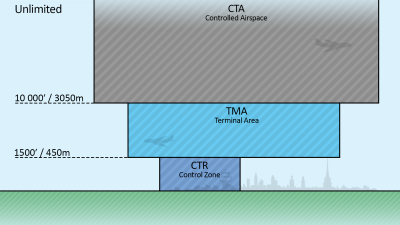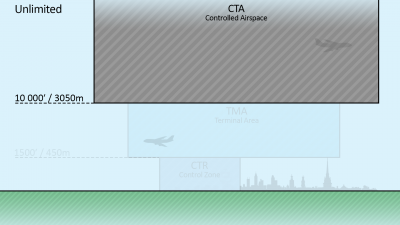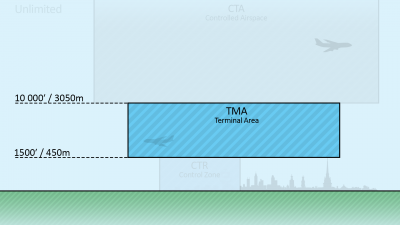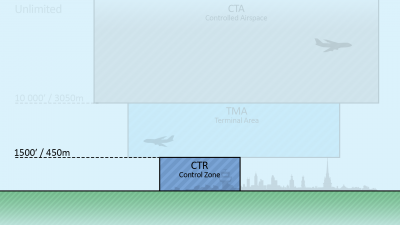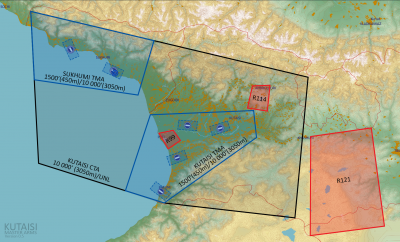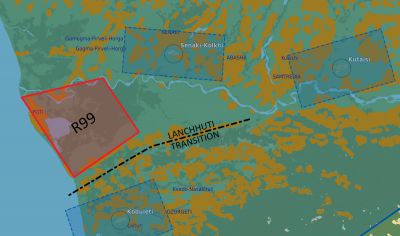Airport Procedures
Home >> Standard Operating Procedures >> Airport Procedures
Though inspired by real life operations, our goal is to strike a balance between realism and manageability. The airspace types listed below are most useful during training events with live ATC in order to increase immersion.
Overview
The airspace structure is usually viewed as an inverted cake, extending from the airport and up.
Airspace Types
Control Area (CTA)
The CTA represents the top of the cake and covers a large area, it’s purpose is to route and separate traffic to, from and through the region. With live ATC the airspace is controlled. It’s bottom starts at 10 000 feet above mean sea level (MSL) and continues to infinity (marked as UNL). Note that you can fly below the CTA.
Terminal Area (TMA)
The TMA is the middle portion of the cake and serves more as a facility to route traffic to and from airports. With live ATC the airspace is controlled. It’s bottom starts at 1500 feet MSL and the ceiling stops at 10 000 feet where the CTA starts. Parts of the the TMA can have a floor defined as 1500 feet above ground level (AGL) due to high terrain elevation. Several airports are located under a single TMA. Note that you can fly below the TMA.
Control Zone (CTR)
The CTR is the top of the inverted cake and covers an airfield. It’s purpose is to protect aircraft departing and arriving at individual airports. With live ATC the airspace is controlled. It reaches from ground level to 1500 feet AGL. Note that you shouldn’t fly below the CTR.
Restricted Area (R)
A restricted area is basically a controlled airspace which is not necessarily close to any airports. They are positioned to protect traffic from live fire. Avoid these unless cleared by ATC or if you are aware of traffic within the airspace.
Departure and arrival
The most common type of departure used is a visual one. Normally ATC will clear you towards an exit point marked on a Visual Operations Chart, you are then expected to navigate visually following the route on the chart. Same goes for arrival.
ATC can also issue specific headings or TACAN radials to follow after take off, in this case the exit points are no longer valid.
Also, read the section about Takeoff Procedures.
Controlled and Uncontrolled Flight
With live ATC all flights are controlled within CTR, TMA and CTA. Players can still fly uncontrolled below TMA and CTA without any clearance, just be aware of your position relative to any airports or restricted areas.
VFR or IFR
Visual Flight Rules (VFR) means that the pilot has navigation responsibility using visual references. Navigation aids such as INS, TACAN or ATC may be used to enhance situational awareness.
Instrument Flight Rules (IFR) can be applied in visual conditions but puts more navigation responsibility on ATC. INS or TACAN etc. may also be used for navigation. IFR flights may be conducted in poor weather.
Speed restrictions
Maintain a maximum speed of 300 KIAS when inside CTR or TMA unless cleared high speed by ATC. This can always be requested but might be denied due to ATC workload.
If there is no ATC available you may deviate from this rule, but you should communicate this with other pilots in the area (on the appropriate channel for the area you are flying in, typically Tower for CTR, Tactical for TMA). Warn other pilots of where you are, where you are going, and that you will be flying at high speed.
Wingmen may exceed 300 KIAS if their flight lead is nearby to rejoin/fix the formation.
This speed restriction is intended to reduce the risk of collision by giving pilots time to find eachother visually, and to give ATC time to manage the traffic.
Landing
See the section about Landing Procedures.
Minimum Sector Altitude
For controllers giving altitude clearances within Kutaisi CTA and around Ramat David, Minimum Sector Alittude (MSA) maps will help to avoid Controlled Flight Into Terrain (CFIT)
Kutaisi CTA
The descriptions above apply to the airspace surrounding the western region of Georgia.
Lanchhuti Transition
Lanchhuti Transition is a local procedure to deconflict departing and arriving traffic from R99 and Kobuleti CTR while flying to and from Kutaisi airfield. It is a VFR transition.
Departing traffic:
- After passing assigned exit point, fly towards and then along the ridge southwest of Kutaisi. Pass between Kobuleti CTR and R99.
- Expect 5000 feet initially and further climb once established along the ridge.
Arriving traffic:
- Expect 3000 feet initially and 1600 feet once clear of terrain.
- Report approaching Entry West if you still have not recieved "Cleared approach" or tower channel by that time.
Resources
In Game Kneeboard
Drop the images contained in the file below in your C:\Users\YOURNAME\Saved Games\DCS.openbeta\Kneeboard folder to access section charts of Kutaisi CTA during flight.
Media:MA Kutaisi CTA kneeboard.zip
Tacview Objects
Drop the XML file into C:\Users\YOURNAME\AppData\Roaming\Tacview\Data\Static Objects to display Kutaisi CTA in Tacview.
LotAtc Overlay
Use the draw tool and open the json file to display Kutaisi CTA in LotAtc.
Media:MA_Master_Kutaisi_CTA_220210.zip
Minimum safe altitude (MSA) for Kutaisi & Ramat David:
